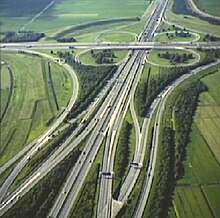Knooppunt Oudenrijn
| Knooppunt Oudenrijn | |
|---|---|
|
|
|
| map | |
| location | |
| Country: | Netherlands |
| Provinces : | Utrecht Province |
| Coordinates: | 52 ° 3 '56 " N , 5 ° 4' 13" E |
| Height: | 2 m above sea level NN |
| Basic data | |
| Design type: | Mixed form of clover / turbine |
| Bridges: | 9 (motorway) |
| Construction year: | 1939 |
| Last modification: | 2014 |
The Knooppunt Oudenrijn is a motorway junction in the Dutch province of Utrecht in the south-west of the city of Utrecht . It connects Rijksweg 2 (A2: Amsterdam –Utrecht– Breda - Maastricht ) with Rijksweg 12 (A12: Oberhausen - Arnhem –Utrecht– The Hague ). It was built in 1939, making it the oldest node in the Netherlands.
The motorway junction is named after the former village and today's district of Utrecht Oudenrijn , north-west of the junction, but now there is only an industrial area of the same name. Until 1954 there was still a church with the name Oude Rrijn (dt. Old Rhine ), the former name of the Leidse Rijn canal , which runs north of the district through Utrecht.
history
The knot as a roundabout
The history of the junction goes back to the 1930s, when the planning and subsequent realization of a crossing point for two Rijkswege began. At that point, Rijkswege 2 , 12 and 26 should cross. Initially, a solution in the form of a clover-leaf motorway junction was considered, but after it was determined that such a solution was too expensive, the planning in the direction of a roundabout motorway junction was intensified.
As early as 1938, the previously two-lane Rijksweg 2/26 was expanded to four lanes in the area north of the future cross. With the completion of the four-lane Rijksweg 12 between the Knooppunt Oudenrijn and Woerden , the junction was opened on November 25, 1939 as a two-lane roundabout. In 1941 a lighting system was installed in the junction before the A12 east of the junction to Utrecht-Hoograven was opened to traffic in 1942 and connected to the motorway junction. In 1948, the southern extension of the A2 to the Lek Bridge near Vianen was also opened to traffic over four lanes. At the same time, two petrol stations were built within the cross in the same year. Due to the increased volume of traffic, the junction was only widened to three lanes in 1959 and then equipped with traffic lights in 1960 to avoid traffic jams.
The knot as a shamrock
In the 1960s, the knot began to be converted from a roundabout to a clover leaf. For this purpose, the outer direct connection ramps were first built. Later, up to the completion on November 13, 1968, the internal indirect connecting ramps were built and the leveling of the lanes was corrected by building a bridge structure.
In 1976, the A2 was expanded to six lanes north of the junction to Knooppunt Holendrecht . In 1977 the parallel carriageway of the A12 in the area of the motorway ring of Utrecht between the Knooppunt Oudenrijn and the Knooppunt Lunetten and thus also the so-called network east of the cross was opened to traffic.
The knot as a hybrid clover leaf / turbine
In 1993 work began on converting the motorway junction to its present-day design. The construction project, opened on June 29, 1996, was intended to significantly increase the capacity of the cross. In order to avoid traffic jams on the busy route, the speed limit on the A12 east of the junction was lowered to 100 km / h on the main lane and to 80 km / h on the parallel lane.
East of the junction, the A12 has had a total of 10 lanes since the completion of the expansion in 2012, consisting of six lanes on the main carriageway and two lanes for each direction on the parallel carriageway.
At the end of 2013, the connecting ramp from the A2 from Amsterdam to the A12 in the direction of Arnhem was expanded to three lanes and the speed limit there was reduced to 80 km / h.
Design
The motorway junction is a hybrid of a clover leaf and a turbine cross. The two connecting ramps with the lower volume of traffic are single lane as indirect connecting ramps like a clover leaf cross. The semi-direct connecting ramps are two-lane each, and the direct connecting ramp from Arnhem to Amsterdam are two-lane and the connecting ramp from Amsterdam to Arnhem is even three-lane. To the north and east of the junction there are so-called braids that enable the connection to the respective main and parallel carriageways of the A2 and A12.



